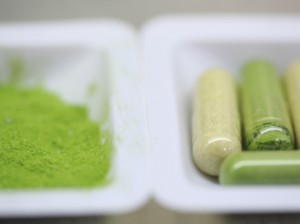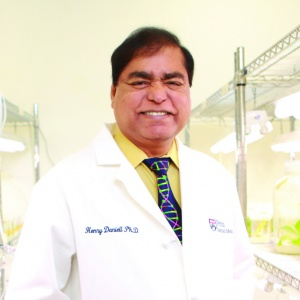New Pulmonary Hypertension Treatment Could Be Derived From Freeze-dried Plant Leaves

 A team of researchers at the University of Pennsylvania and the University of Florida have identified a pulmonary hypertension treatment using a drug grown in the leaves of plants from Penn’s high-tech greenhouse.
A team of researchers at the University of Pennsylvania and the University of Florida have identified a pulmonary hypertension treatment using a drug grown in the leaves of plants from Penn’s high-tech greenhouse.
This potential mode of therapy, addressing a disease for which few therapy options exist, derives from the work of molecular biologist Henry Daniell, now a professor of biochemistry and pathology, and director of translational research at Penn’s School of Dental Medicine, who has pursued basic science research with a focus on plants since earning his biochemistry Ph.D. from Madurai Kamaraj University in his native India. Dr. Daniell says he began to think differently about his work upon recognizing what he perceived as a human-rights injustice: the sky-high costs of medications taken for chronic or lengthy illnesses.
For example, in a 2013 Penn release, Dr. Daniell observes that Interferon, a common cancer drug, costs $30,000 to $40,000 for a four-month treatment, and a third of the global population earns $2 or less a day. If you have something that saves lives, you have an obligation to make it available to everyone, he contends.
[adrotate group=”4″]
Consequently, Dr. Daniell’s life’s work has centered on research and development of a unique means of delivering drugs and vaccinations to the human body. Instead of relying upon sterile injections to ferry the therapeutic protein of interest to the intended tissue, he’s turned to natural vehicles — plant leaves. His research has demonstrated the effectiveness of plant-based vaccines and therapeutics in treating nearly 30 conditions, from infectious diseases such as cholera, malaria, and anthrax, to autoimmune diseases such as diabetes and hemophilia.
Plant-based vaccines possess several advantages over their conventional counterparts. They’re shelf-stable and don’t require refrigeration. In addition, because plants are commonly consumed foods, most people will not be allergic to them as they might be to some synthetically produced drugs, or those based on egg proteins, to which substantial numbers of people are sensitive. And they’re safer because they only contain proteins from a pathogen, rather than the pathogen itself.
However, perhaps the greatest advantage of these vaccines and therapeutic agents is their cost. They’re relatively cheap and can be easily grown; Dr. Daniell has reported that just an acre of genetically modified tobacco plants, for example, could produce enough anthrax vaccine to immunize every person in the United States.
[adrotate group=”3″]
 Manufacturing these so-called “green vaccines” does not require expensive purification equipment, and transporting and storing them doesn’t require a costly “cold chain” of refrigeration. Freed from these constraints, Dr. Daniell says the therapies could be produced and distributed relatively inexpensively, even to remote areas where refrigeration and electricity are rare commodities.
Manufacturing these so-called “green vaccines” does not require expensive purification equipment, and transporting and storing them doesn’t require a costly “cold chain” of refrigeration. Freed from these constraints, Dr. Daniell says the therapies could be produced and distributed relatively inexpensively, even to remote areas where refrigeration and electricity are rare commodities.
Results of the current Penn/UoF study are published online in the September issue of the journal Hypertension entitled “Oral Delivery of Angiotensin-Converting Enzyme 2 and Angiotensin-(1-7) Bioencapsulated in Plant Cells Attenuates Pulmonary Hypertension”HYPERTENSIONAHA.114.03871 (HYPERTENSIONAHA.114.03871, Published online before print September 15, 2014, doi: 10.1161/HYPERTENSIONAHA.114.03871) The paper’s coauthors are Vinayak Shenoy, Kwang-Chul Kwon, Anandharajan Rathinasabapathy, Shina Lin, Guiying Jin, Chunjuan Song, Pollob Shil, Anand Nair, Yanfei Qi, Qiuhong Li, Joseph Francis, Michael J. Katovich, Henry Daniell, and Mohan K. Raizada, variously of the Departments of Pharmacodynamics (V.S., A.R., M.J.K.), Physiology and Functional Genomics (C.S., Y.Q., M.K.R.), and Ophthalmology (P.S., Q.L.), University of Florida, Gainesville; Departments of Biochemistry and Pathology, School of Dental Medicine, University of Pennsylvania, Philadelphia (K.-C.K., S.L., G.J., H.D.); and Department of Comparative Biomedical Sciences, Louisiana State University, Baton Rouge (A.N., J.F.).
Dr. Henry Daniell was a senior author on the study, Fellow Penn Dental Medicine authors included postdoctoral associate Kwang Chul-Kwon and research assistants Shina Lin and Guiying Jin. The Penn team collaborated with researchers from the University of Florida, including Vinayak Shenoy, an assistant research scientist in the College of Pharmacy Department of  Pharmacodynamics; co-senior author Mohan Raizada, a distinguished professor of physiology and functional genomics in the Evelyn F. and William L. McKnight Brain Institute; and Michael Katovich., a professor in the College of Pharmacy.
Pharmacodynamics; co-senior author Mohan Raizada, a distinguished professor of physiology and functional genomics in the Evelyn F. and William L. McKnight Brain Institute; and Michael Katovich., a professor in the College of Pharmacy.
The coauthors note that emerging evidence indicates diminished activity of the vasoprotective axis of the reninangiotensin system, constituting angiotensin-converting enzyme 2 (ACE2) and its enzymatic product, angiotensin-(1-7) contribute to the pathogenesis of pulmonary hypertension (PH). However, they have determined that long-term repetitive delivery of ACE2 or Ang-(1-7) would require enhanced protein stability and ease of administration to improve patient compliance.
They further observe that Chloroplast expression of therapeutic proteins enables their bioencapsulation within plant cells to protect against gastric enzymatic degradation and facilitates long-term storage at room temperature. Besides, fusion to a transmucosal carrier helps effective systemic absorption from the intestine on oral delivery.
In patients with pulmonary hypertension, the arteries of the lungs become constricted, which increases the workload on right side of the heart to pump blood through the lungs. Over time, the right chamber of the heart, which usually is small, becomes enlarged and dysfunctional. Currently, the most successful drugs for the disease cost tens of thousands of dollars.
Dr. Daniel has demonstrated that plants have several properties that lend well to producing and carrying biomedical molecules in the body. First, their cells are totipotent; that is all the different tissues of a plant can be grown starting from a single cell in a culture dish. This characteristic enables scientists to make modifications to one plant cell and, from that, grow a plant in which every cell has those modifications.
Plant cells also have fibrous walls made of cellulose, which cannot be broken down by human enzymes, though they can be degraded by the microbes that reside in the gut. This feature enables therapeutic proteins produced inside plant cells to travel partway through our digestive systems before being released in the intestines, where they can disseminate into the bloodstream.
Since developing the concept of a plant-based vaccines in the 1990s, Dr. Daniell has methodically tested each step from introducing proteins into a plant, to designing molecular tags to direct the proteins from the gut into the bloodstream or immune system, to harvesting and freeze-drying the specially engineered plants in capsules.
In 2012, Dr. Daniell and colleagues published a paper in the Journal of Plant Biotechnology describing the creation of lettuce plants engineered to express a protein that stimulates the pancreas to produce insulin. Mice fed capsules of the freeze-dried plant material produced insulin and had normal sugar levels in their blood and urine, the appearance of a functional cure for diabetes.
What’s more, the capsules could be stored at room temperature for as long as 15 months and retain their potency. Similarly, a 2010 publication in the journal PNAS demonstrated the ability to block severe immune reaction and death in hemophilic mice. His lab has also developed oral vaccines against cholera, malaria, tuberculosis, anthrax and plague.

“Pulmonary hypertension is relatively a rare disease. It’s been neglected by the industry, and so there aren’t many drugs out there,” says Dr. Shenoy. “The first drug for pulmonary hypertension was approved in 1995, although the disease was known since the early 1900s.”
Dr. Raizada notes that blood pressure is regulated by a hormonal system called the renin-angiotensin system. Too much of a key hormone in this system, angiotensin II, can raise blood pressure. However, angiotensin II is balanced by two other hormones , ACE 2 and Ang-(1-7), that maintain normal cardiopulmonary pressure, according to previous research.

These studies have shown that increasing the amount of these hormones in the body prevents pulmonary hypertension, but the researchers needed an effective way to deliver the hormones to test their therapeutic potential. Because the hormones are already found in the human body, Dr. Raizada says, they had little concern about potential side effects.
“All of the drugs on the market so far for hypertension and cardiovascular diseases are based on inhibiting angiotensin II and aren’t very effective,” Dr. Raizada says. “Many years ago, we began to question why the prevalence of hypertension and cardiopulmonary diseases does not decrease when you inhibit angiotensin II. Instead, we thought we should be targeting the hormones that balance angiotensin II”
Dr. Daniell studies protein drug delivery using plants and introduced genes with the ACE 2 and Ang-(1-7) proteins into plant chloroplasts of tobacco, which then could be grown, freeze-dried, enclosed in capsules and fed to rats. Plant cells protect protein drugs from acids and enzymes in the stomach, but drugs are released in the gut for absorption when bacteria in the gut digest plant cell walls. To make sure the proteins could travel across the intestinal wall and into the bloodstream, they were fused with a protein that binds to intestinal cells.
“The proteins we were dealing with are very large and unstable, only lasting a few minutes in the bloodstream when given as an injection,” Dr. Daniell explains. “We needed to find a way to stabilize the proteins to increase their lifespan in the bloodstream and make sure it was working the way we wanted it to.”
The scientists observe that patients treated with other medications typically see only a slight improvement — about a 10 percent reduction in pulmonary pressure. After rats with established pulmonary hypertension had been treated with medication for two weeks, their pulmonary pressure was reduced by 20 percent. After four weeks of using the plant-delivered medication to treat a group of 8-10 rats with pulmonary hypertension, the researchers found that the medication reduced pulmonary pressure by 32 percent.
Though pulmonary hypertension causes vessels in the lungs to constrict, patients actually die from heart failure. But the drug also improved function on the right side of the heart, potentially avoiding heart failure in patients, Dr. Shenoy says.
Next, the researchers hope to test the drug in clinical trials.
“The bottom line is we have been able to find a revolutionary way to deliver a therapy through oral delivery for a disease which is in critical need for an immediate innovative therapy,” Dr. Raizada maintains.
“This will be a paradigm shift in delivery of drugs,” Dr. Daniell told Penn Current. “This will change the landscape and save lives.”
The study was funded by the National Heart Lung and Blood Institute, National Institutes of Health and American Heart Association, and this trial is registered at ClinicalTrials.gov with trial identifier NCT01884051 (https://www.clinicaltrials.gov).
Sources:
University of Pennsylvania
University of Florida
Penn Current
Hypertension
Journal of Plant Biotechnology
Image Credits:
University of Pennsylvania
University of Florida







